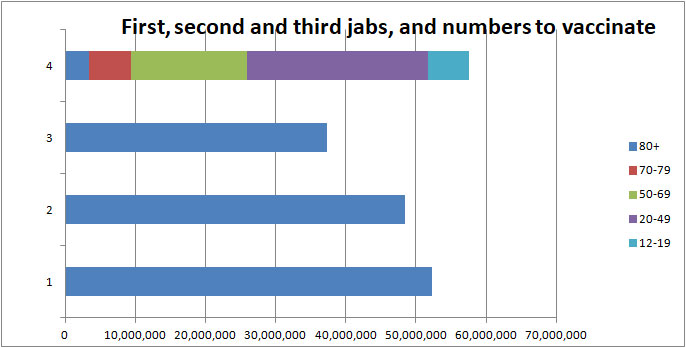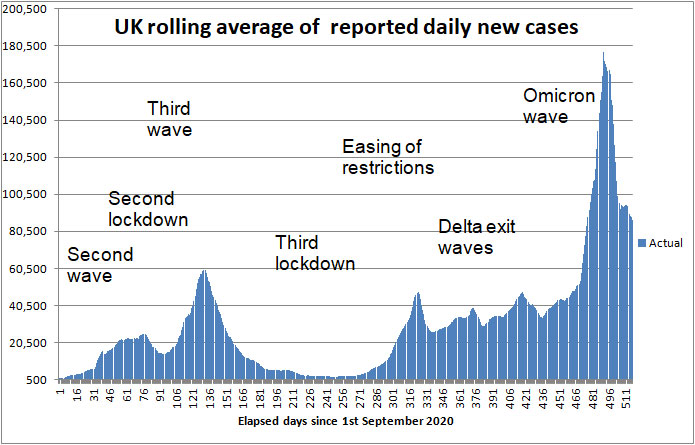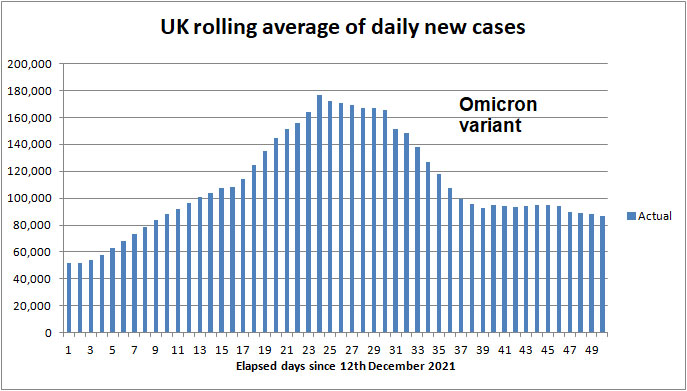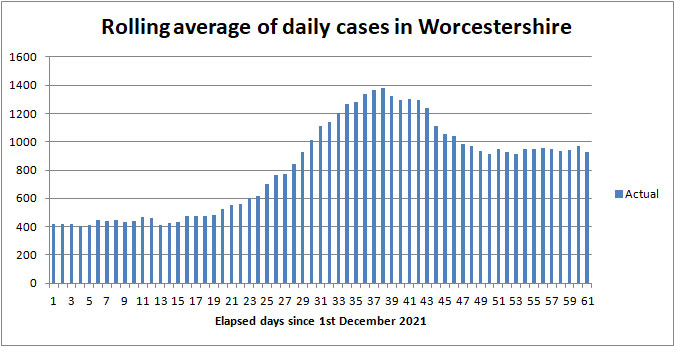
Angus and Rosemary's Miscellany
of Malvern - Other Resources
|
Coronavirus (COVID-19) epidemic weekly update for Malvern Seniors30th January 2022 TIME TO TAKE STOCK PreambleWe keep an eye on the published government figures and monitor the media to asses the level of risk for Seniors in the Malvern Hills district. We also provide links to where further information can be found. This page is normally updated every Sunday between 1800 and 2400 hours GMT. Information about Coronavirus can be found on the NHS website: https://www.nhs.uk/coronavirus ContentsFurther information: About the Zoe COVID symptom study About the NHS contact tracing app SummaryIt's now probably time for life to return to normal, especially for those of us who are in reasonable health and have had three doses of the vaccine. While the Omicron virus remains prevalent there is a fair chance we will all catch COVID-19 at some time or other. It may send us to bed for a few days and it could take a week or two for us to recover, but we are unlikely to be hospitalised and our resistance to future infection will be bolstered. COVID hospital Intensive Care beds are now said to be mostly occupied either by those who are unvaccinated or have had only 2 doses of the vaccine, so make sure to get your booster jab if you have not already done so. Lateral Flow Device kits which only require a nose swab can be used to test for COVID at home, for example before either going to an event or visiting friends. A local summary of COVID cases can be found on the Worcestershire Coronavirus Dashboard. Note: use the arrow <> buttons at the bottom of the Dashboard screen to move between pages. Click for Worcestershire County Council COVID-19 news Click for Simple Summary of Malvern numbers on the Coronavirus dashboard Click for the latest UK Government Coronavirus advice How to get vaccinatedUnder the government's plan to deal with the Omicron Emergency, all those aged 16+ years are now eligible to book a booster 3 months after their second dose. Click NHS link - Who can get a coronavirus (COVID-19) vaccine From Monday 31st January vulnerable children aged 5 - 11 years can be vaccinated; this may be by invitation - ask your GP. For information about walk-in centres in Worcestershire go to the website: and click the Vaccine Rollout tab at the top of the page. Click for information about vaccination at the Three Counties Showground Otherwise either see the NHS website for walk-in opening times and vaccine availability: Or click this link for more information and to book a vaccination on-line: Book a Coronavirus vaccination - NHS (www.nhs.uk) Note: the immuno-compromised may be offered a third jab as part of their primary course, followed by a booster 3 months later. More about vaccinationsThe Omicron variant is now dominant and still spreading rapidly. It can make you 'very poorly' so it is essential to get your booster jab if you have not already had it. VaccinometerOur bar chart below shows the total number of:
Vaccinometer as of 30th January 2022 You won't see much change from last week's chart as the vaccination rate has slowed to a snail's pace compared to pre-Christmas. The population of the UK aged 12+ is about 58M, so were everyone in that age group to be fully vaccinated the lower two blue lines showing 1st and 2nd doses should ideally reach 58M. Progress towards that goal is now slow. Currently there are almost 6M in this age group who are unvaccinated, which is a lot, and 4M still to get their 2nd dose. That alone is not enough and a third jab is necessary to obtain protection from Omicron. Click for NHS video warning young people of the dangers of the virus for the unvaccinated. Vaccination statistics can be found on the Vaccination tab of the Coronavirus Dashboard. Booster jabsThe number of booster jabs given in England can be found in a spreadsheet on the NHS England website. Look in the data section for the COVID-19 daily announced vaccinations Excel file which gives a breakdown of jabs by region and age. Click for NHS COVID-19 vaccinations A summary can also be found on the Coronavirus Dashboard. The government says everyone aged 18+ years has been offered a booster jab. To date about 48M have had two doses, and just over 37M booster doses have been administered, suggesting 11M still to boost in the UK. Vaccinations WorldwideA chart of the worldwide vaccination situation can be found on the Our World in Data website. Click for worldwide statistics Hint: click the country list on the left hand side of the screen to add or remove countries from the chart.
|
| Districts of Worcs | Cases | Weekly increase | Population |
| Bromsgrove | 25,471 | +943 | 98,529 |
| Malvern Hills | 13,080 | +855 | 77,545 |
| Redditch | 22,011 | +857 | 85,317 |
| Worcester | 24,193 | +1,423 | 103,542 |
| Wychavon | 26,488 | +1,351 | 126,240 |
| Wyre Forest | 23,100 | +1,057 | 100,957 |
| TOTAL | 134,343 | +6,734 | 592,130 |
| COMPARE WITH | |||
| County of Hereford | 36,263 | +2,225 | 195,000 |
| Leicester (city of) | 98,980 | +3,016 | 400,000 |
Cumulative cases reported by PHE in Worcestershire to 30th January 2022
Note: the weekly increase is indicative; the seven day average by area, which varies day to day, is an alternative metric that can be found on the Coronavirus dashboard.
The main point to note is that cases in Worcestershire and Herefordshire remain high. Daily cases in the city of Leicester have gone down a bit.
Cases in Malvern Hills by age group
On the cases tab of the Coronavirus dashboard you can either select the county of Worcestershire or a local authority such as the Malvern Hills, and there you can find a heat map showing cases by age group over time and a chart comparing the number of cases under 60 years with those aged 60+.
The latest figures show the infection rate rising steeply in those aged 0-59 and falling in those aged 60+ where the case rate is about 5 times lower.
The rolling number of cases per 100,000 per week reported for 24th January has fallen to 262 in the over 60s but risen to 1,318 in those aged 0 - 59 years.
Click for cases by specimen date age demographics in the Malvern Hills
Interactive maps
At the bottom of the Coronavirus Dashboard (daily update) page there is an Interactive Map which is coloured to show infection rates across the country. This shows high infection rates across much of England but cases falling in Wales and parts of Scotland
Click for Interactive Map of COVID cases
Note: the Interactive Map works on desktop PCs but it's possible you may encounter difficulties using a tablet or smartphone.
Recent weekly cases to 25th January are: North Malvern 111; Malvern Link 87; Pickersleigh 86; Barnards Green 66; Malvern Wells and Priory 58; Callow End and Hanley 44; Upton and Welland 38.
Another map can be found on the Zoe COVID Study website indicating extrapolated cases based on reports from those using the Zoe app.
Click for People with COVID (estimated from the Zoe app)
Number of deaths
Statistics on COVID deaths are published by Public Health England, The Office of National Statistics, and NHS England.
 PHE figures
PHE figures
Public Health England reports that the cumulative total of COVID (28) deaths in UK hospitals and care homes rose by 1,836 in the last week to 155,698 with the daily average flat-lining at about 262 deaths per day.
In comparison averaged over recent years 1,700 people die daily from all causes.
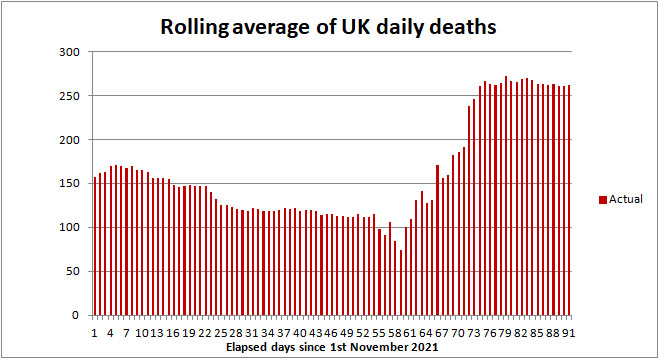
COVID-19 death rate 1st September 2021 to 30th January 2022
Click to view the UK government Coronavirus Dashboard
Note: according to an article in the Daily Telegraph, Sajid Javid suspects the upturn in the death rate may be due to an increasing number of elderly patients, testing COVID positive, dying from other causes.
Sajid is reported as saying up to 44% of currently reported cases might not be directly attributable to COVID (also see note on ONS deaths below).
ONS figures
The Office of National Statistics (ONS) separately reports registered deaths in England and Wales where COVID-19 is mentioned on the death certificate. The ONS figures lag the PHE figures by 10 - 14 days and do not include Northern Ireland and Scotland.
Click for national ONS data on deaths (Excel spreadsheet)
The ONS figures are broken down by District providing a glimpse of where deaths are occurring. The provisional cumulative total of COVID related deaths in Worcestershire reported by the ONS up to 14th January (week 2 of 2022) is shown below.
Note: the numbers are from the ONS Death Registrations-Pivot table
| Districts of Worcs |
Deaths 2020 |
Deaths 2021 |
Deaths 2022 |
Week 2 | Population |
| Bromsgrove | 164 | 142 | 5 | 4 | 98,529 |
| Malvern Hills | 61 | 98 | 4 | 3 | 77,545 |
| Redditch | 108 | 109 | 1 | 0 | 85,317 |
| Worcester | 87 | 134 | 3 | 2 | 103,542 |
| Wychavon | 157 | 154 | 2 | 0 | 126,240 |
| Wyre Forest | 171 | 132 | 2 | 1 | 100,957 |
| TOTAL | 748 | 769 | 17 | 10 | 592,130 |
Provisional cumulative COVID-19 deaths registered by ONS to 14th January 2022
Note: summation of rows 9 to 339 of the ONS deaths Registrations-Pivot table (after correction by ONS).
There was 1 death in a care home, 1 at home, 1 in hospital and 1 other in Bromsgrove; 2 deaths at home and 1 in hospital in the Malvern Hills; 2 deaths at home in the city of Worcester; and 1 death in hospital in Wyre Forest.
In England and Wales 1,377 COVID-19 related deaths were reported in the week to 14th January, 459 more than the week before. Of these 189 were in a care home, 125 at home, 12 in a hospice, 1,044 in hospital and 7 elsewhere.
Note: after adding Scotland and NI figures the ONS weekly death rate (1,557) appears a tad lower than the weekly increase reported by PHE on 16th January (1,833). This suggests possibly 276 people per week dying within 28 days of a positive test, with no mention at all of COVID on the death certificate (see commentary).
The provisional UK COVID-19 death toll (as reported by PHE and ONS) for all weeks of the epidemic can be found on the Deaths tab of the Coronavirus Dashboard.
Click for ONS Coronavirus (COVID-19) latest insights: Deaths, dated 26th Jan
NHS England figures for Worcestershire
The table below shows latest COVID deaths in Worcestershire hospitals reported by NHS England on 28th January 2022.
| Worcestershire | Cumulative deaths | Past week |
| Acute hospitals | 937 | 11 |
| Care hospitals | 65 | 0 |
| TOTAL | 1,002 | 11 |
Click for NHS COVID-19 total announced deaths
Click for Summary of Malvern numbers on the Coronavirus dashboard
Risk of COVID-19 death by age band (Delta)
NHS England provides an analysis of COVID-19 deaths in hospital in England and Wales by age band. Shown below is a breakdown of deaths for the period 1st August 2021 to 25th November 2021 when the daily death rate fell to 125.
| Age band | Number of Delta deaths | % of deaths |
| 0 - 19 | 29 | 0.3 |
| 20 - 39 | 157 | 2 |
| 40 - 59 | 1,058 | 11 |
| 60 - 79 | 4,062 | 43 |
| 80+ | 4,134 | 44 |
Relative risk of COVID-19 death by age band for Delta variant
Those aged 60+ years account for 87% of deaths compared to 92% last year, but remember that due to vaccination the death rate as a proportion of new cases is five to ten times lower than in 2020.
Many historic deaths are likely to have been of the vaccine-hesitant, and those with co-morbidities such as Diabetes, the frail, and those that are immuno-compromised. Pregnant mothers, the overweight and deprived individuals with a poor diet are also said to be at increased risk.
An NHS leaflet offered to patients being admitted to hospital suggests we are at higher risk of complications from COVID-19 infection if we have one or more of the following conditions:
-
Age over 70 or Male over 50;
-
Lung problems (including asthma, COPD, emphysema, bronchitis, bronchiectasis;
-
Heart disease
-
Diabetes
-
Chronic kidney disease
-
Liver disease (eg hepatitis, cirrhosis)
-
Brain or nerve problems (eg Parkinson's disease, motor neurone disease, multiple sclerosis, cerebral palsy)
-
You have a condition that increases the risk of infection
-
Take medication that affects the immune system, (eg steroids)
-
Very obese (BMI over 40)
-
Pregnancy
Recent figures from the ONS suggest healthy individuals with no underlying conditions are at low risk of dying from Omicron, but of course few Seniors fit that category.
The age distribution of deaths for Omicron is likely to be similar to that for Delta. See link to the latest UKHSA vaccine surveillance report below which points to an analysis covering a mix of Delta and Omicron cases that also highlights that many deaths are now of vaccinated individuals by virtue of a large proportion of the population being vaccinated and the vaccines not giving 100% protection.
Click for UKHSA COVID-19 vaccine surveillance report Week 4, 27 January 2022
 Healthcare numbers
Healthcare numbers
The UK government Coronavirus Dashboard includes important information about healthcare statistics and NHS bed occupancy.
| Hospital COVID cases (UK) | Number | Change since last week |
| Patients currently in hospital | 16,149 | -1,827 |
| Patients on ventilation | 549 | -115 |
| Patients admitted daily | 1,732 | -242 |
Headline summary of patients in hospital reported on 30th January 2022
The trend in UK bed occupancy continues downwards.
Bed numbers by region in England
Tabulated figures for COVID bed occupancy in England can be found on the NHS England website and these give a good indication of direction of travel:
Click for NHS England COVID-19 Hospital bed Activity statistics
Note: see the latest Daily Admissions and Beds spreadsheets, then look for all COVID beds.
| Region | 21st January 2022 | 28th January 2022 | 15th January 2021 |
| London | 2,918 | 2,537 | 7,811 |
| Midlands | 2,832 | 2,582 | 5,890 |
Comparison of All beds COVID data for London and Midlands
In the last week the number of COVID-19 General and Acute beds fell by 13% in London, where Omicron seeded first, while in the Midlands COVID beds fell by 9%.
For the same period, COVID beds in England fell from 14,865 to 13,462 a drop of 9.5%.
For comparison, the number of beds occupied during the peak of the epidemic in January 2021 is shown in red in the right hand column of the table.
 Worcestershire hospital beds
Worcestershire hospital beds
Tabulated figures for bed occupancy in Worcestershire Acute and Care hospitals can also be found on the NHS England website.
A summary can be found on the UK government Coronavirus Dashboard which reports on 25th January there were 71 COVID-19 patients occupying Worcestershire Acute Hospital beds, of which 5 are ventilated beds; roughly 26% of the peak experienced last January and 13 less than last week.
Some of these may be patients testing COVID positive after admission to hospital for other reasons.
Note 1: patients entering hospital for elective procedures normally have to test COVID negative before admission, but not patients arriving via A&E; some transmission in hospitals possible.
Note 2: Healthcare statistics can be found on the Healthcare tab of the UK Coronavirus Dashboard. At the top of the page where it says Healthcare in United Kingdom, click the drop down arrow to select Area Type as NHS Trusts, and Area Name as Worcester Acute Hospitals.
Click to view Worcester healthcare figures
Alternatively,
Click for Summary of Malvern numbers on the Coronavirus dashboard
Deaths in Malvern Hills
There was 1 death within 28 days of a positive test for coronavirus reported on 28 January 2022. Between 22 January 2022 and 28 January 2022, there have been 2 deaths within 28 days of a positive coronavirus test.
Forecast for the week ahead
Trends suggest that during the next seven days (up to 6th February) the cumulative total of UK COVID-19 cases reported by PHE on the Coronavirus Dashboard could increase by 550,000 towards 17,000,000 with the rolling average of daily new cases falling towards 75,000.
In Worcestershire up to 6,500 new cases of the Omicron COVID-19 variant can be expected, and up to 900 cases in the Malvern Hills district.
The number of UK COVID (28) deaths (as recorded by PHE) may increase by 1,700 towards 157,400 during the 7 days ending 6th February 2022, with the average daily death rate roughly flat-lining at 245.
In the county of Worcestershire, assuming a 0.2% death rate, the 6,486 new cases this week could translate to a maximum of 13 COVID deaths per week towards the end of February.
Daily hospital admissions are likely to flat-line next week.
Longer term outlook
General
Some pundits were expecting cases to fall quite sharply, as they did in South Africa. The fact they haven't makes it is difficult to predict how fast daily cases will fall in February and the residual (endemic) level of infection.
The recent 'plateau' in daily cases may have been partly due to rising cases in schoolchildren and anticipation of the relaxation of PLAN B restrictions in England.
Half term may cause cases to dip slightly.
Ratios
For a fixed level of vaccination, daily cases have been a signpost to whether daily hospital admissions and deaths are going to go up or down. Based on our heuristic 'rules of thumb' hospital admissions and deaths during early January appeared to be to following daily cases very roughly in the ratio:
-
Hospital admissions 1:75 of daily cases reported by PHE, lagging by 7 days, of which perhaps up to half are 'true' COVID admissions;
-
Deaths 0.18% of daily cases reported by PHE, lagging by 15 days of which perhaps only half are 'true' COVID deaths.
-
UK Hospital bed occupancy - roughly 8 times daily hospital admissions, lagging by about a fortnight.
Now daily cases are about to include repeat infections and reported deaths are higher then expected, these estimates need revision and thought.
Advice for Seniors
We judge the risk of exposure to the Omicron variant still to be HIGH; see our riskometer opposite.
How this affects you will depend on your vaccination status. UKHSA say those who have had two doses plus a booster have roughly a 12% chance of being hospitalised compared to the unvaccinated.
Two doses give little or no protection.
6M people remain unvaccinated in the UK and for many time is running out; perhaps up to 6,000 will die unnecessarily in coming weeks.
Recently there have been no more than 11 COVID related deaths per week in Worcestershire which has a population of 600,000 so we currently judge the risk of death for triple vaccinated Seniors to be fairly LOW while the risk of Long COVID might be MODERATE .
In these uncertain times, when it is quite possible, despite being triple vaccinated, for Seniors to become ill with the Omicron variant of COVID-19, the simple safeguards to remember are to:
-
book your booster dose as soon as you are contacted by either your GP or the NHS; between five days and two weeks after the booster most people should be well protected from severe illness;
-
don't forget your flu jab;
-
wash your HANDS thoroughly, using soap and hot water, for 20 seconds, including after handling deliveries to your home, to kill virus picked up from contaminated surfaces (see note 1);
-
ideally wear either a well fitting FACE covering, FFP2, or N95 face mask when unavoidably near other people for example when in shops, health-care settings, and when using public transport;
-
SPACE at least 2 metres from people you don't feel safe with (see note 2);
-
preferably socialise with friends and other households outdoors in the FRESH AIR else, if you are indoors, either ventilate by keeping windows open as far as is practicable or put a HEPA air purifier in the room;
-
consider avoiding crowded indoor settings and minimise TIME near strangers;
-
self-isolate and take a Lateral Flow test if you feel unwell with cold or flu like symptoms; according to the Zoe COVID Study the current top five symptoms amongst the double vaccinated and children, in order of prevalence, are said to be runny nose, headache, sneezing, sore throat, and persistent cough, which are often hard to distinguish from a common cold - you might alternatively suffer from fever with a temperature of up to 103 deg F, and a slight reduction in sense of taste;
-
consider taking a Lateral Flow test before visiting others (see note 3);
-
respect others and give them space.
Notes:
1) Wash your hands thoroughly before touching your face to avoid transferring virus from contaminated surfaces to your mouth, eyes and nose. If outdoors use an alcohol based hand gel.
2) Two metres is further than you think - roughly an arm and a walking stick away.
3) The COVID Symptom Study people suggest that if you have symptoms of a common cold there is currently a 50% chance you might have COVID.
Annex
Commentary
General
There is quite a lot to talk about this week - and we thought it's time to take stock.
COVID-19 is constantly mutating with some variants being labelled of interest or concern. In 2021 the biggest concern was Delta which came from India and swept across the globe, and in December 2021 the Omicron variant arrived from South Africa which is now dominant; there will be others.
Omicron is rumoured to cause milder illness than Delta, by which is meant it puts less people in hospital; this will partly be because the population is vaccinated and has gained resistance from previous infections.
Two doses of the Wuhan vaccine (eg Astrazeneca, Pfizer and Moderna) and a booster are necessary to protect the healthy elderly, and pregnant, from hospitalisation following infection by Omicron.
Omicron is prevalent in the community and, despite triple vaccination, there is a fair chance Seniors will catch it at some time, with some feeling very poorly at home for a week or two.
An unlucky minority, mostly the very elderly, frail and unvaccinated, will die either at home, in a care home or in hospital.
An earlier infection with Delta is said to provide little protection from catching Omicron but, like vaccination, it may protect against hospitalisation.
Those that are healthy and triple vaccinated should now be able pursue a normal life but some, for example those with underlying conditions and the immuno-suppressed, might have difficult choices to make in consultation with their doctor.
New variant Omicron BA.2
Since the first warnings of COVID-19 emerged in China in January 2020, waves of COVID variants have spread rapidly across the world. The latest is Omicron BA.2 or PLUS which is more infectious than the original Omicron BA.1 virus that only emerged in December. PLUS is now overtaking BA.1, so will become predominant in the UK in a month's time, as is happening in Denmark and Israel. As far as is known Omicron BA.2 does not cause a more serious illness, so there is nothing new to worry about.
Be aware though that when doctors talk about a mild illness they mean one that does not put you in hospital. That does not rule out Omicron making you feel 'very rough' for one to two weeks at home!
Vaccination of NHS staff
Doctors have learnt how better to manage the disease; vaccines have been developed; old medicines have been found useful and new antiviral drugs have been developed.
The vaccines developed to fight the original Wuhan strain still provide protection from serious illness and hospitalisation, providing a third booster dose is given, but they do little to prevent transmission.
The original plan to mandate the vaccination of all care and NHS staff to protect against the Delta variant made sense, but while Omicron remains the predominant strain, and until a better vaccine is developed, mandatory vaccination makes little sense - as it doesn't greatly reduce transmission. The government could therefore reasonably extend the deadline and not sack the 5% of NHS staff refusing to be vaccinated.
Coronavirus dashboard figures
As we come towards the end of the epidemic questions are emerging about the accuracy and value of the Coronavirus Dashboard figures.
Cases
Until now a person who tests COVID positive is only counted once. For example if they are infected by Delta and several months later by Omicron the Omicron infection is not counted. So cases of Omicron are currently being under reported; by how much we don't know.
From 31st January that will change and repeated infections will be included, so a step up in the number of daily cases can be expected.
The main concern at the moment is rising cases in unvaccinated children who are in turn infecting their parents. Once this flare up has burnt itself out UK daily cases should resume falling.
Deaths
Reported COVID (28) deaths have been flat-lining at about 262 deaths per day in the UK, when we expected the daily death rate to fall, both due to daily cases dipping from their peak, and assuming Omicron causes milder illness than Delta.
One explanation being put forward is that all deaths within 28 days of a COVID positive test are being counted, including those dying with no mention of COVID on the death certificate.
If it is assumed 1,700 people on average die every day from all causes and 1 person in 30 currently has COVID symptoms, then 56 people per day might be expected to die with COVID, but not necessarily of it, eg about 400 per week. That is not far from the figure of 276 by which PHE deaths currently exceed ONS deaths.
Many of those dying are said to be aged 80+, unvaccinated, and beyond the average lifespan which could explain why excess deaths are now zero or negative compared to 5 years ago.
Sajid Javid's suggestion that 44% of recently reported COVID (28) deaths are not 'true' COVID deaths may prove fairly accurate.
Hospital beds
Similar reasoning can be applied to hospital beds. The bed count includes those who either catch COVID in hospital or test positive soon after admission. Many of these patients are said to have either mild or no symptoms and are not struggling for breath as they were in January 2021.
The main point to note is that number of ventilated beds has fallen from a peak of about 4,000 to 540 despite many more daily cases being recorded.
We think the number of general beds occupied by COVID patients should have fallen a little further, if they were tracking daily cases; this may be because of a rise in repeat infections which so far have not been counted.
Vaccination of the public
The efficacy of the present vaccines is expected to wane over time, and there is an emerging school of thought that if you are triple vaccinated and are otherwise healthy it might be better to catch Omicron now, further building up your resistance to future infections, rather than later when your resistance is lower.
However, possibly there will be booster vaccinations for the frail and elderly in the autumn and new vaccines offering protection from a broader spectrum of variants.
A sizeable portion of the UK population remains unvaccinated and more work is needed by doctors and within communities to explore people's individual fears and encourage them to get the vaccine.
It is said 98% of pregnant women with COVID in hospital are unvaccinated. Originally there was caution in case the vaccine affected the unborn child, but now the evidence points the other way - to life endangering illness if the mother is not vaccinated.
Facemasks
It's funny that when the outbreak began in early 2020 the government and its advisers said that facemasks were of little value, when 100 years ago it was known they were. Perhaps this had something to do with the fact the shops had sold out and you could not buy them, though face coverings could be made at home.
Then the government did a U turn and made them compulsory.
Since the government relaxed restrictions many people are keen to continue wearing their facemasks. For us that works until we have to put our glasses on when the lenses mist up and we can't see - removing the facemask then seems a better option than having a fall.
A face covering can only help a bit - if you are in a room for a long time with a lot of virus in the air it will seep round your mask, and given Omicron is very infectious your protection is probably more imaginary than real. Ventilation of the room then becomes more important.
A well fitting FFP2 grade mask would give you more protection for example on crowded public transport.
Daily cases
The chart below compares actual daily cases with our projection made 2 weeks ago. The main point to note is that daily case have continued to plateau for a second week, although there are signs daily cases may soon resume falling.
The plateau may be due to rising infection amongst unvaccinated nursery and primary schoolchildren huddled in poorly ventilated classrooms; who in turn infect their parents and carers.
Actual daily cases are shown in red. In the first half of December cases were mostly Delta, then the Omicron wave grew displacing Delta reaching a peak about 7th January. Cases then began to fall but have levelled off in the last fortnight. Shown in blue is our illustration of what we thought might happen based on a Logistic curve which is shown just to emphasise the levelling off in daily cases.
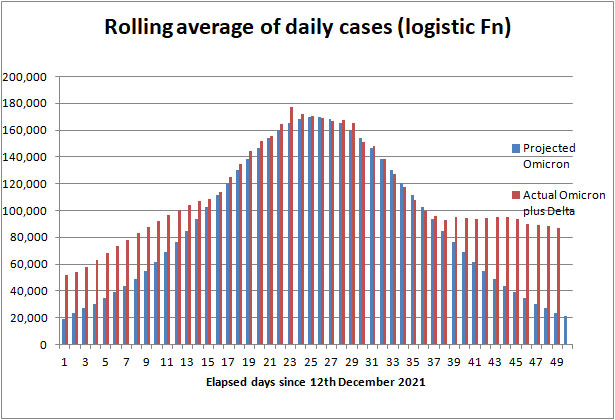
Comparison of actual and last week's projected UK daily cases
Currently there is no discernable trend we can project into February.
This week
The media frenzy over alleged parties at 10 Downing Street fizzled out towards the end of the week when it appeared Sue Gray's report would be delayed.
The restriction on care home visitors will be removed from Monday 31st January.
Click for BBC article - Covid: What are the care home visiting rules and how are they changing?
Cases of Omicron are spreading rapidly throughout western Europe with the BA.2 sub variant of Omicron becoming dominant in Denmark. Cases are also rising sharply in Israel and the USA.
COVID video updates
The usual charts can be found in the Zoe COVID Study and Independent SAGE weekly updates.
Click to watch Zoe COVID Symptom Study update on 27th January 2022 presented by Tim Spector (worth watching).
Bullet points:
- about 1 person in 30 currently has symptoms of COVID;
- cases are highest in the north of England;
- about 34% of new cases are at least double vaccinated;
- of 1,800 daily COVID hospital admissions about 50% are not directly related to COVID ;
- according to ONS, deaths are now less than 5 years ago;
- daily cases in children rising steeply;
- daily cases in those aged 35-55 years up a little, probably infected by children;
- BA.2 spike in Denmark, this variant currently 5% of UK cases;
- perhaps just 8% of cases are reinfections while REACT study suggests 65%.
Click to watch Independent SAGE update on 28th January 2022
The Independent SAGE update starts with the usual review of the charts and is followed by a discussion of how doctors should 'listen more' to patients eg those with long COVID.
U3A
Some groups have started meeting again in person. Attendance is about 50% of normal with some saying they may wait a week or two before coming back.
Overseas travel
Situation remains fluid, refer to current government advice, and prepare contingency plans in case circumstances change in the country you are visiting.
Soon double vaccinated travellers arriving in the UK will not have to take a test.
Travellers visiting the EU may need a booster dose.
List of vaccines
Here is the updated list of COVID-19 vaccines ordered by the UK. It looks as though for now the government has settled on Pfizer as first choice with Moderna second and Astrazeneca held in reserve.
Valneva has been cancelled, and approval has not yet been sought for using Novavax in the EU and US although approval has been sought for use in third world countries.
For two doses plus boosters, only about 200M doses will be needed in 2021 and Jan/Feb 2022 for the population of the UK. The government has now signed deals to buy 114 million additional doses of the Pfizer (54M) and Moderna (60M) vaccines to use in 2022 and 2023.
The press announcement goes on to say that 60M doses of Novavax vaccine are expected to be delivered in 2022 and 7.5M doses of GSK/Sanofi, so there seems no intention to cancel these late arrivals.
Click for Guardian report - Novavax expected to be become fourth Covid vaccine available in UK
| COVID-19 vaccine | Doses ordered (million) | Status |
| Pfizer BioNTech, two dose, -70 deg C | 40+60+35 | Approved, deliveries continuing, made in Belgium (EU). An additional 60M doses have been ordered for booster shots for the most vulnerable in the autumn. A further 35M doses were ordered in August 2021 for delivery in 2022. |
| Astrazeneca, two dose, fridge | 100 | Approved for those aged 30+ years; deliveries continuing. Batches made in UK, Belgium and India. |
| Moderna, two dose, -20 deg C | 7+10 | Approved. First deliveries to Wales and Scotland 7th April 2021 then England 13th April; mainly for those aged under 50 years awaiting vaccination. |
| Valneva, two dose | 60+40 order cancelled |
A jab from French company Valneva will be made in Livingston, West Lothian, Scotland. Order cancelled September 2021. Delivery had been expected to start in second half of 2021. |
| Janssen, single dose | 20 | Approved, a jab from Belgian firm Janssen, owned by Johnson and Johnson; UK approval 28th May. Order reduced from 30 to 20M. |
| Novavax | 60 | A jab manufactured by US firm Novavax being made in Stockton-on-Tees UK; phase III trials complete, but approval has not yet been sought in EU and US. Glaxo Smith Kline (GSK) contracted to fill and package vials. Delivery expected in 2022. |
| GSK Sanofi | 60 | Some delay due to adjusting the formula to give better protection to the elderly; expected approval and delivery of 7.5M doses in 2022. |
| Curevac | 50 ? | Contract placed with German company Feb 2021. Possible source of new variant vaccine; disappointing trial results have resulted in the company working on a second generation vaccine. Future uncertain. |
Table of vaccines ordered by the UK government
 Present rate of new cases
Present rate of new cases
The average rate of infection per 100,000 population per week copied from the Coronavirus Dashboard is shown in the following table.
| Region | Case rate (last week) |
Case rate (this week) |
| England | 974 | 984 |
| Wales | 480 | 547 |
| Scotland | 529 | 470 |
| Northern Ireland | 1,353 | 1,630 |
| London (region) | 847 | 835 |
| Worcestershire | 1,033 | 1,104 |
| Malvern Hills | 737 | 977 |
Seven day Case Rate per 100,000 reported 30th January 2022
Cases went up in the Malvern Hills but otherwise roughly flat-lined last week.
As a yardstick we suggest a figure of below 10 can be considered LOW, so there is a long way still to go.
How to request a COVID test
In order to protect others it is important to get a test and self isolate if you feel unwell with either classic COVID symptoms, or cold and flu like symptoms which can be caused by the Delta variant.
There are now two types of test you can get. The more accurate PCR test involving a throat and nose swab which is sent to a laboratory for analysis and the Lateral Flow Device test.
Click for government guidance on types of tests
Getting a PCR test
Click the link below for information on how to get a free NHS PCR test if you think you may have Coronavirus:
https://www.gov.uk/get-coronavirus-test
We feel the website discourages people from seeking a PCR test who don't have all the classic symptoms. If you feel strongly enough, press on answering the questions so as to get your PCR test.
In case of difficulty you can try phoning the Coronavirus contact centre by dialing 119.
Alternatively settle for a 'Nasal swab' Lateral Flow Device test in the comfort of your own home (see below).
According to Google there is a 'drive through' COVID testing station at County Hall near the Countrywide Centre, and a 'walk through' at Pershore.
There is also a COVID testing station at the Worcester Royal Hospital for screening patients before admission.
If you cannot get to these you can order a home PCR test kit.
If you test COVID positive you should self-isolate for 10 days.
Getting a Lateral Flow Device test
Lateral Flow Device tests (LFD) can either be booked at Claremont Pharmacy in Barnards Green, Evans Pharmacy in Malvern Link, or taken at home.
The test is intended to screen those who do not show the classic symptoms of COVID-19 and provides a means to check you are 'virus free' at home - either before visiting an elderly person, going to work, or attending a crowded event. It also provides a means to check whether or not you have Coronavirus if you are feeling poorly with cold and flu like symptoms.
 You
can collect home test kits,
for example packaged as the COVID-19 Self-Test (Rapid Antigen Test) in boxes
of 7 tests, from Malvern library, the Co-op, and most pharmacies such as Boots and Murrays in Church
Street, Claremont House and Lloyds in Barnards Green, Murrays at Prospect
View, Evans and Murrays in Malvern Link, and Boots and Morrisons on the
Enigma Retail Park.
You
can collect home test kits,
for example packaged as the COVID-19 Self-Test (Rapid Antigen Test) in boxes
of 7 tests, from Malvern library, the Co-op, and most pharmacies such as Boots and Murrays in Church
Street, Claremont House and Lloyds in Barnards Green, Murrays at Prospect
View, Evans and Murrays in Malvern Link, and Boots and Morrisons on the
Enigma Retail Park.
If collecting from a pharmacy you now have to go on-line and get a collection code to present to the pharmacy in order to obtain a pack of 7 tests. This involves giving NHS Test and Trace your email and/or mobile phone number and address.
http://www.gov.uk/get-collect-code
The LFD now comes in two versions.
-
The Throat and Nose Swab kit;
-
The Nose Swab only kit (Orient Gene, Acon Flowflex and MP Biomedicals).
(Lateral Flow Device cassette shown on the right).
ACON Flowflex comes in a blue and white pack.
Orient Gene comes in a green and white pack.
MP Biomedicals come in a blue, white and grey pack.
Click for instructions for using the LFD test kits
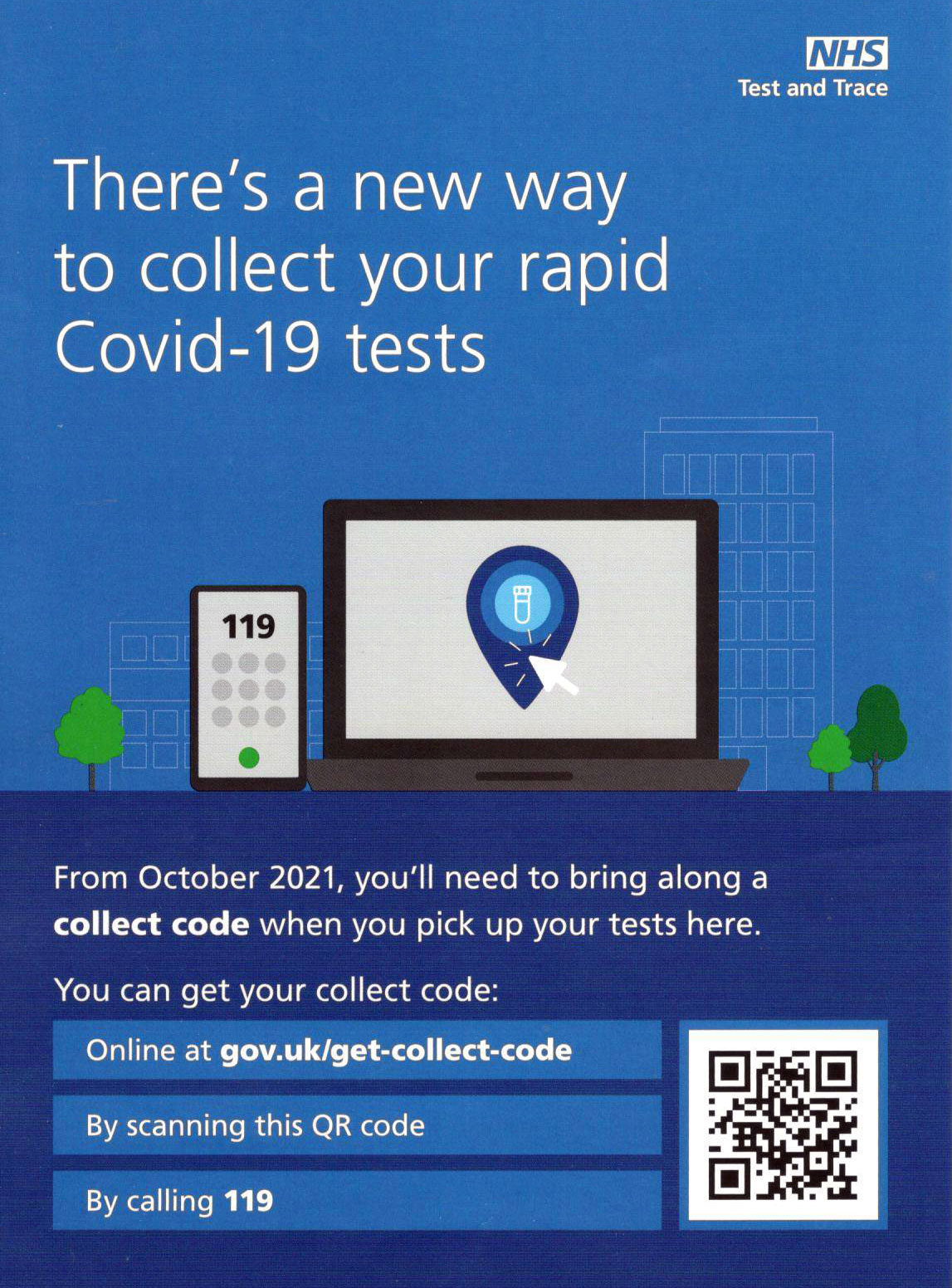
Leaflet at Boots the Chemist
The new Nasal swab test kit which only requires a nose swab is the easiest to use and the best one to get but it is not yet widely available. On 10th November we found Boots in Church Street and Malvern Library were still supplying the old Throat and Nose kit; Murrays in Church Street had the new kits and Malvern library thought the library in St John's Worcester might have the new kits.
Click for NHS information on Rapid Lateral Flow Test sites and collection sites in Malvern
Hint: to see the list, click on 'filter' and then 'pick up sites for test kits' checkbox.
Click for WCC info about Lateral Flow Tests
In our opinion, many Seniors will find the classic Throat and Nose Swab home test kit difficult to use as you need to rub the tonsils or thereabouts with the swab-stick without touching the tongue, teeth, cheeks, gums or any other surface before swabbing the nose. Doing this standing in front of a mirror on your own without gagging while holding a torch in the other hand, won't be easy unless you have a steady hand and good eyesight.
The Nose Swab kit is by far the best one for testing yourself at home.
If you test COVID positive you should isolate and take a more accurate PCR test to confirm the result.
NHS Test and Trace want people to report the result of their home LFD tests within 24 hours at:
www.gov.uk/report-covid19-result
This helps NHS Test and Trace monitor where the issue of the free LFD tests is proving most effective and the spread of the disease.
However, it's tedious to enter your Lateral Flow Test result on the government website and we imagine many people now don't bother.
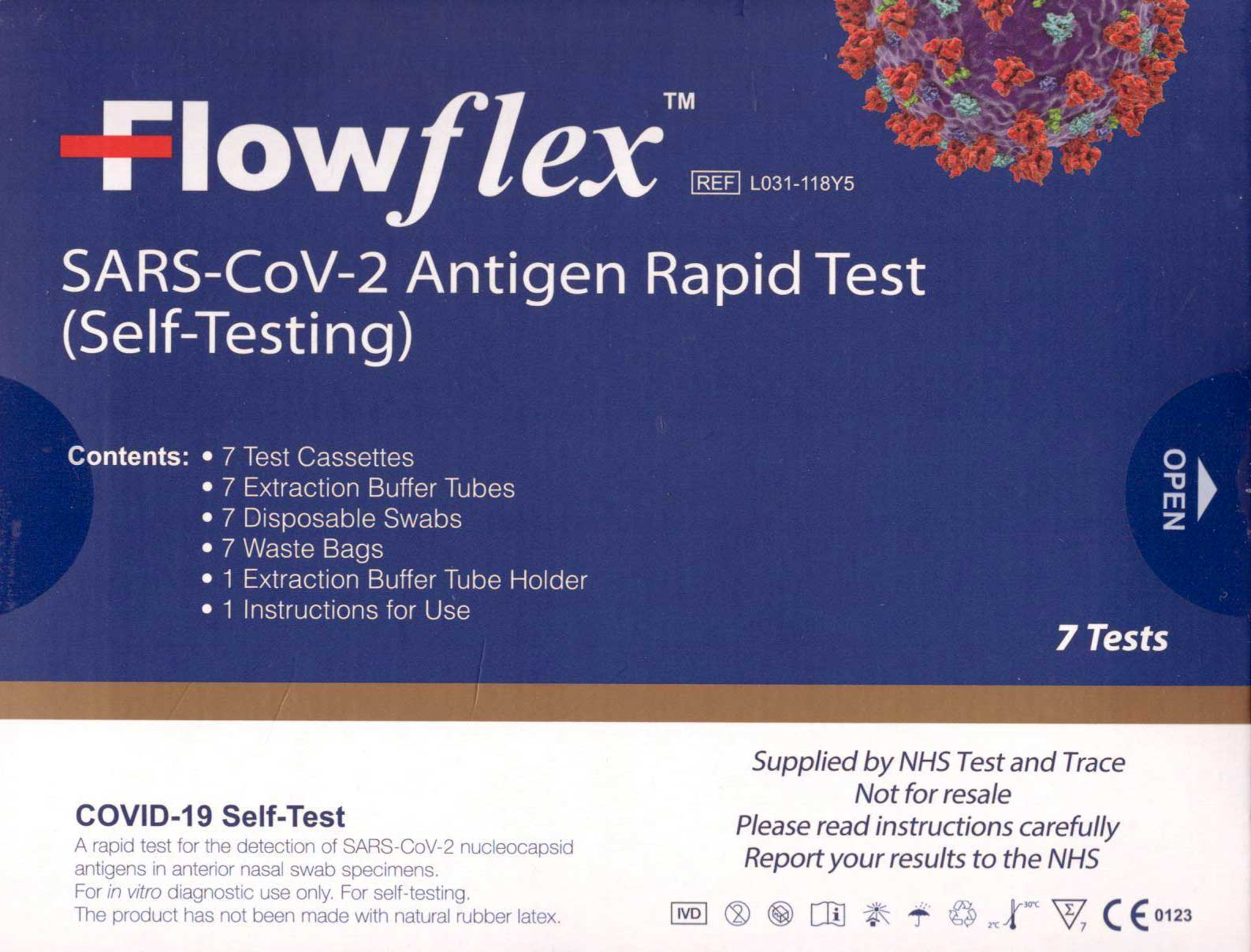
Nose swab home test kit obtained from Murrays
About the COVID Symptom Study app (Zoe)
 You
can help others by downloading the COVID Symptom Study app onto your
smart-phone or Ipad and reporting how you feel either daily, or as you are
able. Note there is no desktop PC version for Windows.
You
can help others by downloading the COVID Symptom Study app onto your
smart-phone or Ipad and reporting how you feel either daily, or as you are
able. Note there is no desktop PC version for Windows.
For further details click this link: https://covid19.joinzoe.com
The Zoe app, which is easy to use, allows you to report whether or not you are feeling well and if you have had a test for COVID. This helps Kings College London monitor the spread and symptoms of the disease and give advice to government. This is an important source of data as we progress through the EXIT wave.
There are questions allowing you to enter your vaccine type and whether any side effects; this now includes boosters and flu jabs.
About the NHS COVID-19 contact tracing app (England)
Release of the NHS COVID-19 contact tracing app for Apple and Android smartphones was announced on 24th September 2020.
Click this link for NHS Coronavirus app information
If you have been close to someone who has tested COVID positive, your smart-phone will be pinged and you may be advised to self-isolate
The period for self isolating keeps changing.
You can now take an LFD test from 6 days after the day your symptoms started, or the day your test was taken if you did not have symptoms, and another LFD test at least 24 hours later.
If both these test results are negative, and you do not have a high temperature, you may end your self-isolation.
Otherwise the isolation period is 10 days.
Bear in mind some individuals may take much longer to fully recover.
Note: be aware triple vaccinated individuals can still catch the Delta variant of the Omicron variant and pass it on to others.
About the NHS app and Covid Pass
An NHS COVID Pass shows your coronavirus (COVID-19) vaccination details and/or test results. This is your COVID-19 status. You may be asked to show your pass to travel abroad, or at events and venues in England asking for proof of your COVID-19 status.
For large UK events you may get in either by the fact:
-
you are fully-vaccinated;
-
you have had COVID as recorded by a positive PCR test;
-
you have taken and reported a recent Lateral Flow test.
You will need the NHS app installed on your smartphone and be registered with the NHS in order to display your vaccination status.
Note: this is not the NHS COVID-19 app
If you don't have a smartphone you should be able to login from a PC to obtain a printed copy.
Click to login from a desktop computer or laptop
You can use your NHS login when signing in to report the result of Lateral Flow Device tests taken at home, which must be done within 24 hours.
Summary of Links
Symptoms
Article about the effects of Coronavirus on the human body
Reporting and how to obtain a test
How to get a test
https://www.nhs.uk/coronavirus
About joining the Zoe COVID Symptom Study:
Guidance
UK government Coronavirus guidance
COVID-19 Response: Autumn and Winter Plan 2021 for England
UK Health and Security Agency (UKHSA) website
COVID Alert states
Guidance on UK COVID-19 alert level methodology: an overview
COVID-19 Alert Level lowered to 3 on 10th May 2021
Tiers
Guidance on tiers: what you need to know
Government postcode checker to find tier for other areas
Statistics
UK government COVID-19: Omicron daily overview
UK government Coronavirus Dashboard
Coronavirus Dashboard Interactive Map
ONS data on deaths in England and Wales (Excel spreadsheet)
NHS England COVID-19 Daily Deaths
NHS England COVID-19 Hospital Admissions
NHS England vaccination statistics
Worcestershire Coronavirus Dashboard
Worcestershire COVID-19 Vaccinations Dashboard
HSA COVID-19 vaccine weekly surveillance reports
Information about NHS hospital bed numbers: past, present, future
A glimpse of the worldwide vaccination situation can be found on the Our World in Data website.
Click for chart showing % vaccinated
Modelling
A forecast of the progression of the COVID-19 epidemic can be found on a University College London (UCL) website.
Click for UCL Long-term forecasting of the COVID-19 epidemic
A projection of the future COVID-19 death toll and daily deaths can be found on The Institute for Health Metrics and Evaluation website.
Click for IHME projection of COVID-19 deaths
Reports
ONS Coronavirus (COVID-19) Roundup
The bigger picture
Worldometer summary of coronavirus cases worldwide
European Centre for Disease Prevention and Control info
https://www.ecdc.europa.eu/en/geographical-distribution-2019-ncov-cases
World Health Organisation info
Window on the USA
Centre for Disease Control (CDC)
American Association of Retired People (AARP)
Worcestershire
Help:
http://www.worcestershire.gov.uk/here2help
Worcestershire County Council COVID-19 information:
http://www.worcestershire.gov.uk/coronavirus
Here you will find a useful link,
'Website: Number of new cases by date in Worcestershire'
which displays interesting COVID charts and statistics for Worcestershire
Miscellaneous
Spanish Flu
Dr Jeff Kildea's commentary about the 1919 outbreak of Spanish Flu in Australia
Views of Martin McKee, Professor of European Public Health
Follow Martin McKee on Twitter
SAGE membership
Scientific Advisory Group for Emergencies (SAGE)
Scottish government:
Link to Scottish Government website
Link to Postcode checker for COVID restrictions by protection level in areas of Scotland
Welsh Government:
Guidance on COVID alert levels in Wales

The interpretations and opinions expressed are our own
Last updated 1st February 2022
 Blogs
>
Blogs
>